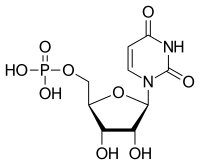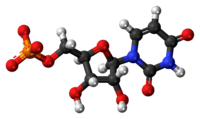Uridine monophosphate
 | |
 | |
| Names | |
|---|---|
| IUPAC name
[(2R,3S,4R,5R)-5-(2,4-Dioxopyrimidin-1-yl)-3,4-dihydroxyoxolan-2-yl]methyl dihydrogen phosphate | |
| Other names
Uridylic acid; Uridine 5'-monophosphate; 5'-Uridylic acid; Uridine 5'-phosphate; Uridine phosphate; 5'-UMP; Uridine 5'-phosphoric acid | |
| Identifiers | |
| 3D model (JSmol) |
|
| ChemSpider | |
| ECHA InfoCard | 100.000.371 |
| MeSH | Uridine+monophosphate |
| PubChem CID |
|
| |
| |
| Properties | |
| C9H13N2O9P | |
| Molar mass | 324.18 g·mol−1 |
| Melting point | 202 °C (396 °F; 475 K) (decomposes)[1] |
| good, also in methanol [1] | |
| Acidity (pKa) | 1.0, 6.4, 9.5 |
| Except where otherwise noted, data are given for materials in their standard state (at 25 °C [77 °F], 100 kPa). | |
| | |
| Infobox references | |
Uridine monophosphate (UMP), also known as 5′-uridylic acid (conjugate base uridylate), is a nucleotide that is used as a monomer in RNA. It is an ester of phosphoric acid with the nucleoside uridine. UMP consists of the phosphate group, the pentose sugar ribose, and the nucleobase uracil; hence, it is a ribonucleoside monophosphate. As a substituent or radical its name takes the form of the prefix uridylyl-. The deoxy form is abbreviated dUMP.
Biosynthesis
Uridine monophosphate is formed from Orotidine 5'-monophosphate (orotidylic acid) in a decarboxylation reaction catalyzed by the enzyme orotidylate decarboxylase. Uncatalyzed, the decarboxylation reaction is extremely slow (estimated to occur on average one time per 78 million years). Adequately catalyzed, the reaction takes place once per second, an increase of 1017-fold.[2]
In humans, the orotidylate decarboxylase function is carried out by the protein UMP synthase.[3] Defective UMP synthase can result in orotic aciduria, a metabolic disorder.
Effects on animal intelligence
In a study, gerbils fed a combination of uridine monophosphate, choline, and docosahexaenoic acid (DHA) were found to have significantly improved performance in running mazes over those not fed the supplements, implying an increase in cognitive function.[4][5]
In foods
In brain research studies, uridine monophosphate is used as a convenient delivery compound for uridine.[6] Uridine is the active component of this compound. Uridine is present in many foods, mainly in the form of RNA. Non-phosphorylated uridine is not bioavailable beyond first-pass metabolism, as it is almost entirely catabolised in the liver and gastrointestinal tract.[7]
See also
References
- 1 2 M. Lide, D. R. Lide: CRC Handbook of Chemistry and Physics. 87. Auflage, S. 3-56, CRC Press, 1998, ISBN 978-0-8493-0594-8
- ↑ Berg J, Tymoczko JL, Stryer L (2006). Biochemistry (6th ed.). San Francisco: W. H. Freeman. ISBN 0-7167-8724-5.
- ↑ Analysis of UMP synthase gene and mRNA structure in hereditary orotic aciduria fibroblasts
- ↑ Holguin, S.; Martinez, J.; Chow, C.; Wurtman, R. (2008). "Dietary uridine enhances the improvement in learning and memory produced by administering DHA to gerbils". The FASEB Journal. 22 (11): 3938–3946. PMC 2574024
 . PMID 18606862. doi:10.1096/fj.08-112425.
. PMID 18606862. doi:10.1096/fj.08-112425. - ↑ Get Smart About What You Eat And You Might Actually Improve Your Intelligence. ScienceDaily, July 3, 2008
- ↑ Wurtman; et al. (2009). "Use of phosphatide precursors to promote synaptogenesis". Annual Review of Nutrition. 29: 59–87. PMID 19400698. doi:10.1146/annurev-nutr-080508-141059.
- ↑ Gasser; et al. (1981). "Novel single-pass exchange of circulating uridine in rat liver". Science. 213 (4509): 777–8. PMID 7256279. doi:10.1126/science.7256279.